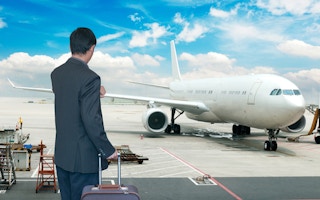Global companies are trying to shrink their carbon footprints by targeting business travel, and the early results are frustrating, even among companies with celebrated green credentials.
Consider Nike, which flew several managers to Davos last month, and was proclaimed by Newsweek to be the greenest US consumer products company back in 2010. Since then, it has revealed that its travel-related emissions soared 89 per cent from 2008 to 2011 — far outpacing the company’s 12 per cent sales growth during that period.
They’re not alone. “Travel is a tough one,” says Andrew Craig, senior manager of environmental initiatives at Royal Bank of Canada. Its travel-related emissions account for 18 per cent of the bank’s total carbon footprint. Its travel emissions climbed 8 per cent last year due to expanding business in Asia and Europe.
RBC’s travel-booking system urges employees to consider alternatives to flying, such as climate-friendlier rail travel, but it’s not mandatory.
Nike, which will release its emissions numbers for 2012 and 2013 this year, declined to comment.
More than 1,150 companies worldwide now track and publicly report the greenhouse-gas emissions produced by their business travel, according to London-based CDP, a non-profit group that surveys public companies about their environmental risks and analyzes the resulting disclosures, for the benefit of institutional investors.
Air travel emits a lots of heat-trapping gases relative to other forms of travel. A round-trip flight between London’s Heathrow Airport and JFK in New York produces about 1.5 metric tonnes of carbon emissions per passenger. That’s about equal to a year’s worth of greenhouse gases for an average citizen of India.
“
More than 1,150 companies worldwide now track and publicly report the greenhouse-gas emissions produced by their business travel, according to London-based CDP
About 2 per cent of global carbon pollution comes from civil aviation. That might not seem like much, but it’s a substantial concentration of emissions from an industry of this size. Aviation is also one of the fastest growing emitters. Surging air travel will cause aviation emissions to jump between 63 per cent and 88 per cent from 2006 to 2020, according to the International Civil Aviation Organisation.
For carbon-conscious companies, particularly in the services sector, air travel presents an even larger challenge. For instance, 42 per cent of PricewaterhouseCoopers’ US emissions come from flights. Twenty-two per cent of Credit Suisse’s carbon footprint comes from global business travel, most of which comes from flying.
Emission-cutting efforts have hit major headwinds. The European Union expanded its market for tradeable carbon-emissions permits in 2012 to cover airlines, including flights originating from outside the EU. This sparked fierce opposition from airlines and governments, including US President Barack Obama, who signed a bill that would shield American carriers from the rules.
The EU suspended its plan for international flights as the ICAO, a UN agency, pursued a separate initiative. In October, the organisation agreed to craft a carbon-reduction blueprint for aviation in the next three years that would take effect by 2020.
“Airplane travel is an environmental no-no,” says Jennifer Woofter, president of Strategic Sustainability Consulting in Herndon, Virginia. “A number of our clients are struggling with this.”
Among the 342 companies in the S&P 500 that report carbon emissions to CDP, 68 per cent now include data on business-travel emissions. Many of the companies report they are attempting to cut back travel-related emissions by encouraging employees to use video-conferencing technology instead.
(Bloomberg L.P.’s business air-travel emissions climbed almost 35 per cent between 2007 and 2012. Curtis Ravenel, global head of Bloomberg’s sustainability group, notes that the company’s travel emissions have grown more slowly than its 52 per cent rise in employee count. “Travel will always be a challenge for us,” he says. “We’re a high-touch business. Customer service is a fundamental part of our business model.”)
Replacing face-to-face meetings is proving difficult for many businesses where a handshake and a shared meal can cement a deal or bolster a key relationship.
“The around-the-table conversation can be so complex with so much going on,” says Dr. Billie Blair, an organisational psychologist and president of Change Strategists Inc, a Los Angeles-based business consulting firm. “Sometimes the nuances of the conversation can only be picked up in person.”
Cisco Systems, which sells a video-conferencing system for businesses called TelePresence, is one of the few companies that have had some success in scaling back their air-travel emissions.
In 2007, the company generated 206,000 tonnes of emissions from its employees’ air travel. Amid the economic slowdown and a reduced travel budget, the company cut that number to 107,000 tonnes in 2010. Since then, its travel emissions have crept up to 139,000 tonnes in 2012, which is still 32 per cent below its 2007 figure.
Cisco is aiming to cut that number even further by 2017. It has equipped 1,655 rooms in its offices worldwide with TelePresence. Workers are strongly encouraged to use the technology for team meetings, interviewing job seekers or routine meetings with partners or customers.
The company also discourages employees from flying to other Cisco offices to meet with colleagues. Snorre Kjesbu, Cisco’s vice president in charge of its TelePresence offerings and other collaboration technology, works from an office in Norway but spends five or six hours a day on TelePresence talking to his team in China or the US.
“I’m in China and the United States every single day,” he says. “Yes, you still need to meet, but you can meet in person much less frequently.”

















